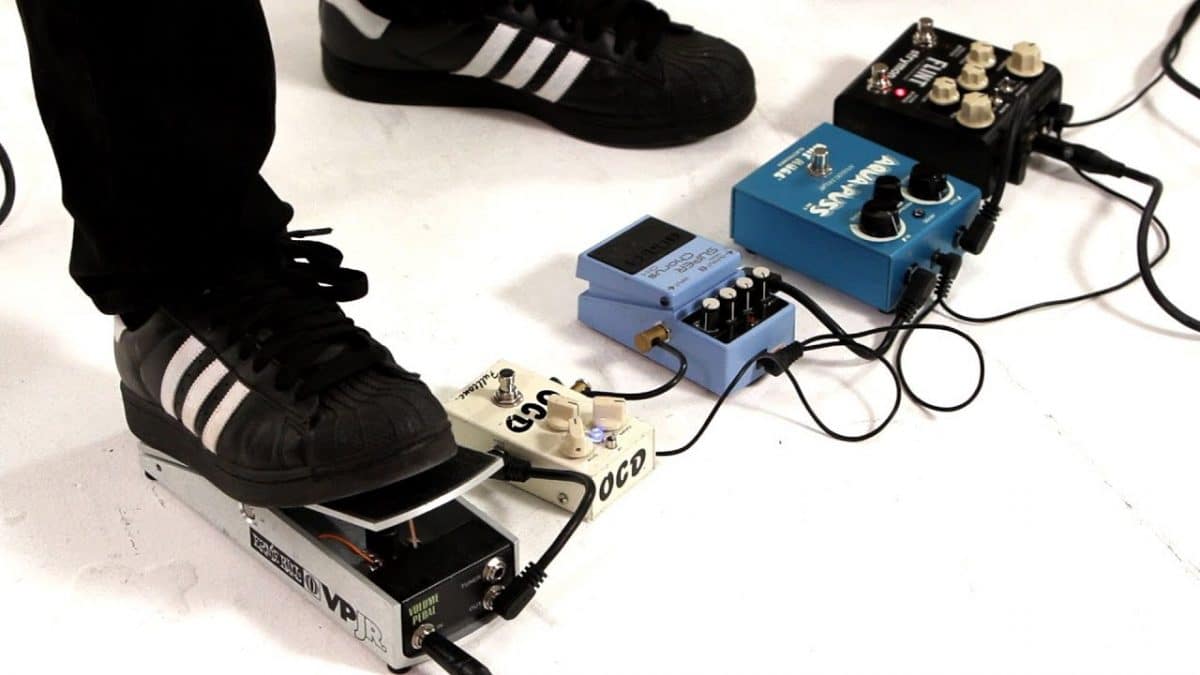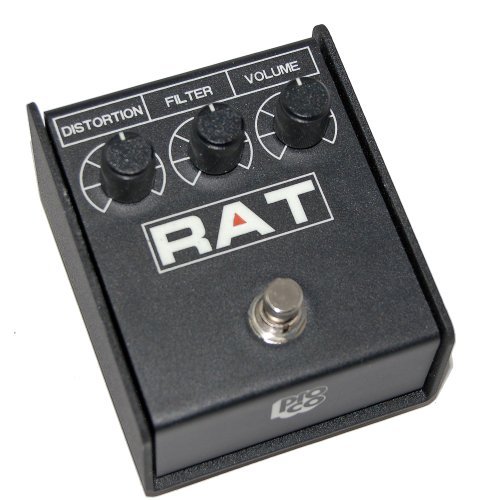An electric guitar is fun. Having a great amp and effects pedals make it even more fun. At some point or another, many electric guitarists will find themselves upgrading and trying different gear. Some simply “settle in,” and are happy with their tone and ability whereas others are likely to go on a long journey to find that elusive “perfect tone.”
Guitarists are always looking for new effects pedals. It becomes an obsession for many tone hungry players. Finding the best gear at the best price makes it all the better. This is a review of the best cheap guitar pedals in 2025 to help you discover affordable pedals that you may have missed. If you’re a beginner guitarist just learning how to play the guitar and are ready to try some new sounds, these are some great options to start with.
Contents
- Features to Consider in Good Guitar Pedals
- Best Cheap Table Saws 2025 (Under $50 / $100)
- 1. Pro Co RAT2 Distortion Pedal
- 2. Jim Dunlop MXR M101 Phase 90 Guitar Effects Pedal
- 3. TC Electronic Guitar Ditto Looper Effects Pedal
- 4. BOSS DS-1 Distortion Pedal
- 5. TC Electronic Spark Mini Booster Guitar Pedal
- 6. MXR M75 Super Badass Distortion
- 7. Boss SD-1 Super Overdrive
- 8. Jim Dunlop MXR Distortion+
- 9. Ibanez TS9 Tube Screamer Classic
- 10. MXR M102 Dyna Comp Compressor Pedal
Features to Consider in Good Guitar Pedals
Like picking an all-time best ice cream flavor or a favorite color to paint your living room, choosing the right guitar pedal is completely subjective. No one can tell you what you’re going to love. However, there’s a lot to know about different kinds of guitar effects and what they can do for you. So, before you start buying pedals at random, you’ll want to get a solid overview of the basics.
Signal Flow
To a huge extent, the path from your guitar to your amplifier is a straight line, and anything you stick into that path will affect everything down the line. That makes the order of your effects almost as important as the kind of effects you put on your pedalboard. While there’s no right way to arrange the pedals, the most common arrangement looks like this: guitar, gain stage, frequency, modulation, time, and amp in that order.
Gain-staging Effects
The first part of your signal chain is where you’ll typically stick any effects that are based on gain-staging. That can range from pedals as mild as clean gain boosts to insane fuzz effects. The important thing to keep in mind is that these pedals shape the foundation of the rest of your tone. You can construct harmonically complex tones with gain-based effects alone, but if you’re at the beginning of an extended signal chain, you may get better results by keeping it simple. There are many kinds of gain-staging pedals. These are:
- Gain Boost – Also called clean boosts, these pedals are in-line preamps designed specifically for high-impedance guitar signal.
- Overdrive – These simulate the breakup you get when you push an amplifier to the point where it starts to distort, emulating the progressive compression and distortion intensity based on incoming volume.
- Distortion – While some rare tube models exist, typical distortion pedals use diodes and some form of a transistor to push incoming signals to the clipping point.
- Compression – They turn down the volume of the signal that’s louder than a certain threshold, decreasing the dynamic range.
- Volume Control – These large rocker pedals are more of a utility than an effect, essentially placing a volume control at your feet.
Frequency Effects
Filtering effects cover anything in the frequency domain, including equalizers, wah-wah effects, pitch shifters, and similar effects. This stage follows gain-staging because gain-based effects tend to add a lot of harmonic complexity to your sound that either negates filtering or produces unflattering results.
- EQ – When it comes to making precise frequency adjustment, sculpting your harmonics, or correcting problems in your tone, nothing does the trick like an EQ pedal.
- Wah-wah and Envelope Filter – The wah-wah lets you sweep the resonant peaking filter manually by rocking your foot.
- Pitch Shifter/Harmony – These come in many styles, from the classic momentary octave up pedal or octave down bass-emulation models to polyphonic harmony pedals that dial in full chords.
Modulation Effects
While modulation pedals affect combinations of gain-staging, frequency, and time, they tend to live in a special place on your pedalboard between frequency effects and more pronounced time-based effects. The term “modulation” just means that the effect is based on changing something over time. In the case of modulation pedals, the change is regulated by a low-frequency oscillator (LFO), and the part of your signal the LFO effects is the biggest defining characteristic in this class of pedal.
- Tremolo and Vibrato – Tremolo pedals modulate volume whereas vibrator models modulate pitch in a way that’s similar to a Leslie rotary speaker.
- Chorus and Flanger – Flanging emulates an old studio trick involving desynchronizing two tape reels, and chorus is the result of an early attempt to emulate flanging that produces a slightly different result. The difference in effect is that flanging produces a distinct rise-and-fall sound, whereas chorus pronounces a more spacious shimmer with noticeably delay.
- Phaser/Phase Shifter – Phaser uses an interesting method of phase cancellation to create several frequency notches and peaks at evenly spaced intervals across the spectrum. An LFO modulates the cutoff frequencies of the phase-shifted signal, causing a gradual sweep similar to flanging, but subtler.
Time Effects
From subtle ambiance to infinitely deep, spacious textures, time-based effects are found on pedalboards throughout all of modern music. They range from distinctly artificial to astonishingly realistic. Like distortion effects, time-based effects pedals are all a matter of taste, and the perfect delay or reverb for surf guitar may have little in common with the one you’d want for a metal lead.
- Delay – This is an effect based on taking the original incoming signal and repeating it some time (or multiple times) later.
- Reverb – The goal of any reverb, regardless of whether you’re using the effect on vocals in the studio or a keyboard onstage, is to create a sense of space around the sound.
Other Effects Pedals
Several additional types of guitar pedals fall somewhat outside this typical pedalboard arrangement, including amp emulators, instrument modelers, loopers, multi-effects pedals, and more.
- Amp Emulation – Lying somewhere between distortion and overdrive, amp-emulation pedals model the specific characteristics of particular styles of guitar amplifiers. They’re a lot like amplifiers, in that there are many of them, and they each offer a different range of tones, from subtle warmth to insane distortion and drive.
- Instrument Modeling – There are some seriously interesting instrument-modeling pedals out there that can transform your sound. You can switch to an acoustic guitar mid-song or turn your guitar into an organ.
- Loopers – The idea is quite simple; you start recording when you step on the footswitch, and when you step on it again, what you just played loops back indefinitely.
- Loop Switchers – Not to be confused with loppers, loop switchers are a major part of advanced pedalboard construction. These devices let you set up independent effects loops that you can switch on and off and arrange in various configurations.
- Multi-effects Pedals – Take all these other pedal types and toss them into one oversized pedal, and you get a typical modern multi-effects pedal.
Advanced Concepts
There are a few advanced concepts that’ll help you make an informed decision about the pedals you buy. These are:
Stereo vs. Mono
Some pedals, particularly time-based types, include the option to run the effect in mono or stereo. The advantage of running pedals in stereo is that you get to take full advantage of the depth and dimension of special effects such as room reverbs and ping-pong delays. The downside is that, unless you’re either recording or running two amplifiers, stereo doesn’t do you much good. What’s more, stereo effects can come with some unpleasant phase-related issues that can cause your tone to be lost in the mix. It’s a bit of a gamble, but when stereo effects work, they’re amazing.
True Bypass vs. Buffered Bypass
This is the topic of endless debates between tweaky guitar players. The simple answer is that neither true bypass or buffered bypass is inherently better than the other. Ostensibly, true bypass completely cuts the circuitry of the pedal out of the signal path when it’s not in use, keeping your signal path free from any additional coloration caused by the pedal’s circuitry. However, there’s still a considerable amount of wiring in guitar pedals, and several true-bypass pedals in a row will add the equivalent of several feet of extra guitar cable.
Buffered-bypass pedals may affect your tone, but the small amount of amplification they provide improves signal retention and fights the high-end attenuation by and extended cable run. If you’re running a few pedals over a small distance, true bypass may be better for you, but if you have a packed pedalboard, then buffered bypass may provide you with a better tone all the time.
Batteries vs. AC
There’s a persistent myth that all AC power supplies are noise and can ruin your sound. While there’s no getting around the fact that bad power can affect your pedals, and batteries will get around that issue, bad power is going to be an even greater problem for your guitar amplifier than your pedalboard. Some pedalboard power supplies are great at fighting power-related noise, but the best thing you can do for your guitar is to get a decent power conditioner and run your amp and pedals through it. That way, you get a clean sound, and you don’t need to worry about juggling 9V batteries when your pedals die mid-show.
Best Cheap Table Saws 2025 (Under $50 / $100)
1. Pro Co RAT2 Distortion Pedal
Editor’s Rating:
Features
Crafted to be used as a primary distortion, this pedal comes in a sturdy grey casing that’s as strong as a tank. There are only three control knobs, but each of them is very sensitive and responsive, allowing you to dial in anything from lighter drive to metal crunch. The zones in which the RAT2 is most comfortable in are the massive rock and hard rock tunes.
Apart from those knobs, there’s the standard on/off foot-switch, making the pedal very clean and sleek in terms of design. As expected, it’s also highly practical. The item features a total weight of one pound and dimensions of 4.8 by 4.5 by 3.3-inches. It can fit any pedalboard and is quite easy to use.
Controls
The distortion knob controls the level of gain and distortion effect. The more you increase it, the more distortion and drive you’ll get. The filter knob makes the pedal stand out a bit. While other pedals have Tone or Brightness knobs, the Filter control operates in a slightly different manner by always retaining a certain foundation of all frequencies. This means that extreme values aren’t useless super-dry or super-wet sounds, but actual tones you can use.
The volume control or the Level knob adjusts the amount of distortion effect that gets injected into your audio output. The more you crank it up, the more distortion and less clean tone your guitar will be included in the mix.
Performance
As far as sound is considered, note that this is a distortion pedal after all, and a powerful one. So if you’re planning to put this one at the sonic forefront, don’t bother buying it in the first place. But if the heavier crunch is what you’re after, you’re going to love the tone here. It’s like the manufacturer hit that sweet spot on a tube amp where it’s going from sparkly clean to warm overdrive.
It works like a charm for solo boosts, as well as for rhythm chugging. The pedal is capable of covering anything from blues to metal, but it’s hard rock where it’s most comfortable. Additionally, the bass frequencies are never truly cut out during the performance, which is a great upside for acquitting that modern sound rooted in traditional values.
Verdict
Seen as one of the very best in the distortion category, the Pro Co RAT2 Distortion Pedal is a clear winner for more than a few reasons. You get superb distortion, fuzz, sustain, and overdrive. You get a real gritty sound with this pedal which is heard mostly in rock and other genres of music. It can be used on bass guitars as well as produces equally spectacular sound and tones. Furthermore, it’s quite possibly one of the very best and most popular guitar pedals out there in terms of responsiveness.
- It can be used as a primary distortion.
- It’s perfect for delivering a sparkly clean overdrive.
- Its RAT2 function allows you to use it for an extra kick.
- The pedal delivers excellent arena rock rhythms.
- It sounds muddy with extended range guitars.
2. Jim Dunlop MXR M101 Phase 90 Guitar Effects Pedal
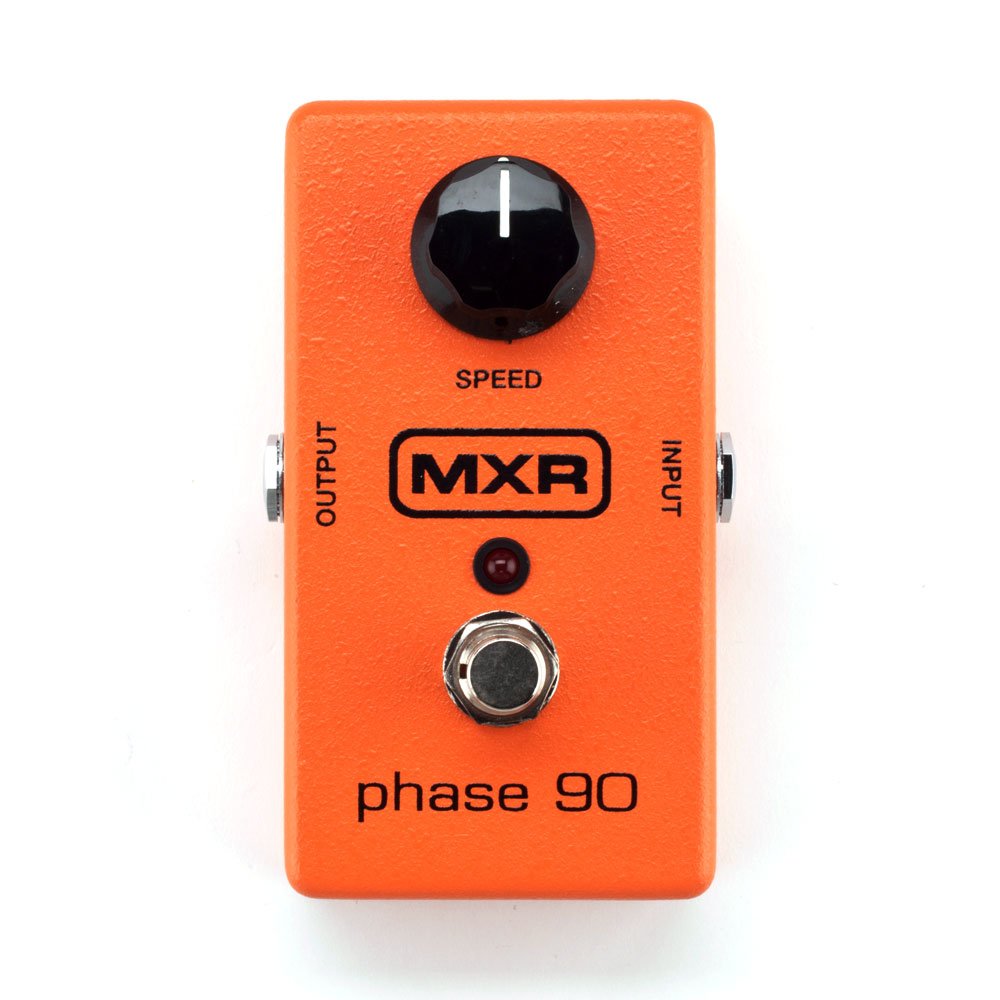
Editor’s Rating:
Features
One of the most respectable things about Dunlop is the fact that they kept the design of the MXR’s pedals intact. Unlike other companies, Dunlop has delivered the good old Phase 90 in its original form. That means an orange box and a single knob to get you started. This is an analog model, so it’s more attractive to those looking for softness and something more natural.
Controls
MXR’s very first successful phaser packed a single control knob. That knob controls the speed or better said, the frequency of the phaser effect. For the most part, that was perfectly enough back in the day. Some guitar players love the simplicity and like to use MXR Phase 90, specifically because of it. Conversely, more modern players will find the lack of controls to be annoying at the least. It’s one of those things that depend on the type of music you play and your overall taste.
Performance
The performance aspect of the MXR Phase 90 is one of the main reasons why people keep coming back to this already archaic analog phaser pedal. MXR’s block logo circuitry isn’t that complicated, but it’s hard to replicate. The fact that Dunlop has managed to do this so well is quite impressive by itself.
Generally, the tone you get is very natural and organic. The effect flows with a certain dose of character, which is something more modern phaser pedals simply lack. If there’s one genre of music for which the MXR M101 is suitable for, it would be rock and blues. Metal is where more clinical and versatile phaser is much more helpful.
Verdict
The MXR M101 Phase 90 is among the most popular phasers on the market at the moment. It’s very simple design is countered by its impressive performance that has kept guitar players from all over the world coming back to it for decades. With that said, it’s not the type of pedal everyone will love. It’s one of those cases where you either find it to be impressive, or simply useless. Rarely is there a middle ground with the MXR Phase 90.
- It delivers a rich, warm, analog tone.
- It can add a shimmery velocity and a dramatic swooshing.
- The pedal is versatile enough to handle any classic recordings.
- It’s very easy to operate.
- The pedal delivers a bit of a slow oscillation noise.
3. TC Electronic Guitar Ditto Looper Effects Pedal
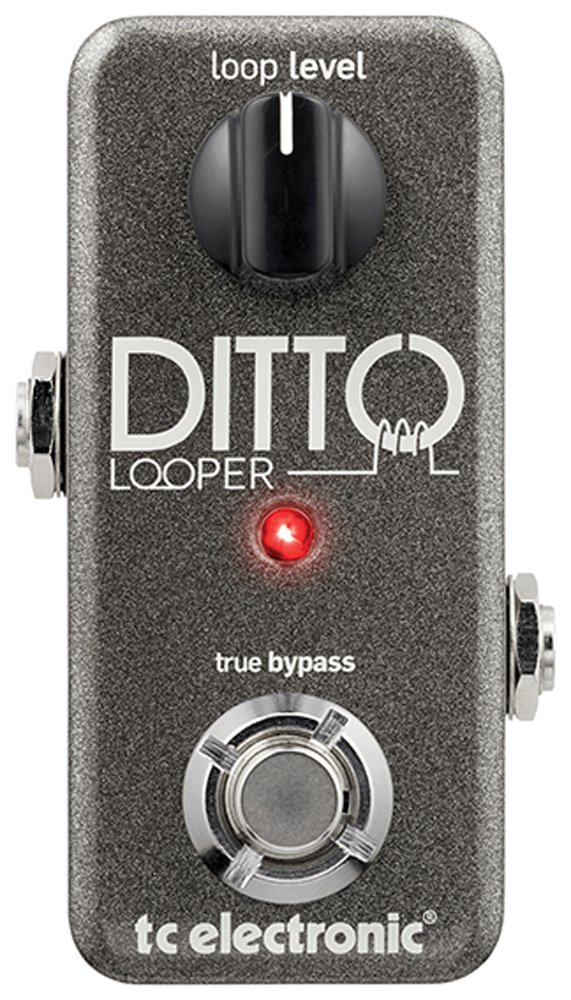
Editor’s Rating:
Features
The Ditto Looper is built with the same high standards of quality as TC’s most expensive gear. It has a beautiful fit and finishes, and it features top-shelf components and soft-touching switching. Signal integrity is maintained by 24-bit DAC technology, true-bypass switching, and analog dry-through signal routing that lets your dry sound ass without being converted to a digital signal. This ensures purity and zero latency.
This pedal is rather simple to use. It allows you to record, overdub infinitely, start, stop, and undo loops and overdubs all by pressing or pressing and holding the pedal’s one button. The control knob adjusts the recorded loop’s volume relative to your dry signal, and there’s an LED that blinks to indicate your loop’s starting point and to indicate when a loop is stored in memory.
Connections include a mini USB jack for receiving software updates from TC Electronic’s website and a jack for a nine-volt power supply, not included. The Ditto Looper doesn’t run on batteries, but 9-volt adaptors from Dunlop, Boss, and others will work.
Performance
The Ditto Looper’s easy operation and compact size make it perfect for live performance. At the same time, Ditto’s intuitive, hands-free operation spurs at-home practice sessions and creativity.
Verdict
The TC Electronic Ditto simplifies looping without sacrificing quality or features, with five minutes of looping time, unlimited overdubs and pristine audio. Moreover, the single knob and switch provide full control over recording, playback, overdub, bypass, and signal level. The analog pass-through circuitry, 24-bit digital conversion, and true-bypass switching maintain your rig’s tonal integrity.
- It provides up to five minutes of loop time.
- It features true bypass switching and analog dry-through signal routing to maintain signal integrity.
- It’s easy to use.
- Some users have complained that it’s not reliable and stops working after using it a couple of times.
4. BOSS DS-1 Distortion Pedal
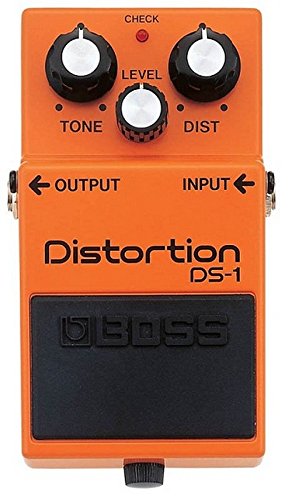
Editor’s Rating:
Features
The BOSS DS-1 is a certified classic helping the likes of Kurt Cobain and Joe Satriani bring life to their sounds that have amazed crowds all around the globe. The pedal is very tough and will take anything you throw at it, despite its tiny compact design.
Controls
The pedal is very simple to use and even comes with an instruction manual covering its basics and a few preset options to help you get started. The Level, Distortion, sand Tone control knobs featured on the pedal will tune and shape your sound whichever way you desire. But it’s not the controls that are the highlight here, it’s the sheer brilliance of the sound output it delivers that made this bad boy famous. You can even use it for bass and keyboard if you own any of those beside your guitar.
Performance
You can get anywhere from low-ends to high gains, pick your favorite artists, pick a favorite song to recreate or build yours from scratch. You’ll amaze yourself, and whoever else has tuned in to listen. This classic is featured as a distortion pedal, but it can also do what an overdrive does. You might need a little experience with it to achieve that, but that’s the beauty of it. It’ll never cease to amaze you.
If you ever decide you need more out of this pedal, you can choose to modify it and take it to levels unheard of before, with even more widening and depth of your sound sparkling with harmony.
Verdict
If you’re looking to add a best-selling distortion pedal to your collection or take it as your first pedal, this genuine classic is the choice for you. It’s simple to use and thrilling to master.
- It’s easy to use and set up.
- The design of the pedal is compact.
- The tough construction of the pedal makes it safe.
- It has very few sound options.
5. TC Electronic Spark Mini Booster Guitar Pedal
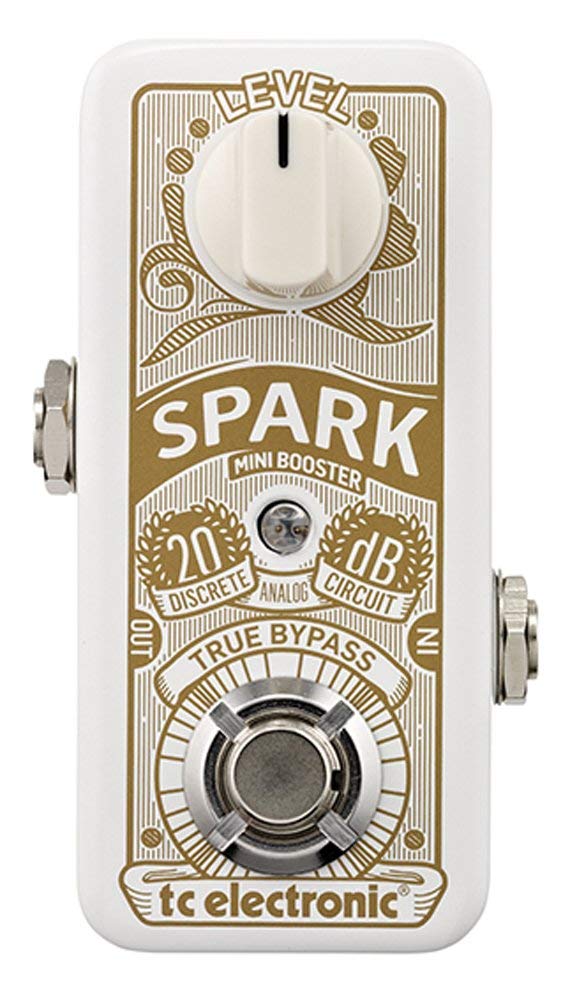
Editor’s Rating:
Features
TC Electronics packed this quality booster circuit into a very attractive enclosure. It has a slim body, one dominant knob that’s also your main control point, and a stomp switch. The only difference, in this case, is that the switch isn’t your standard unit. Instead, it features their PrimeTime technology. This means it has two modes of operation. You can either activate the pedal by pressing the switch like you would any other, or you can press and hold the switch to activate the pedal for shorter periods. While it might not seem to be all that practical on paper, it’s a great tool when you’re using the pedal as a solo boost. That type of versatility puts the device shoulder to shoulder with some of the best pedals on the market.
Controls
The controls come in the form of one knob that you use to add gain to your signal. This is the very same design that most vintage boost pedals have, and a good portion of modern ones as well. Boost is the type of effect that can do just fine with such a rudimentary interface. After all, that’s one of the things that makes it so attractive to numerous guitar player around the world.
Performance
TC Electronic Spark Mini Booster is a fully analog pedal that delivers one of the best boost effects you can find at the moment. It’s crystal clear for the most part, adding no changes to the timbre of your guitar, while it’s perfectly capable of infusing the signal with 20-decibels of additional gain. The PrimeTime stomp-switch works as advertised, and it’s quite reliable all things considered. This combination of great performance and increased functionality makes TC Electronic Spark Mini Booster one of the more competitive booster pedals on the market.
Verdict
No matter how silly it sounds, it’s hard to add a new twist to something as simple as a boost pedal. If you try hard, you can easily change what this pedal is all about and that defeats the purpose altogether. TC Electronic managed to introduce something while also sticking to what makes boost pedals so great. The result is a capable package that promises to deliver a lot of versatility to whoever is using it.
- It gives off a clean sound every time it’s in use.
- It allows for +20-decibels of gain control.
- The transparent setup allows musicians to work easily.
- It’s challenging for drummers to align the input jacks and the DC input.
6. MXR M75 Super Badass Distortion
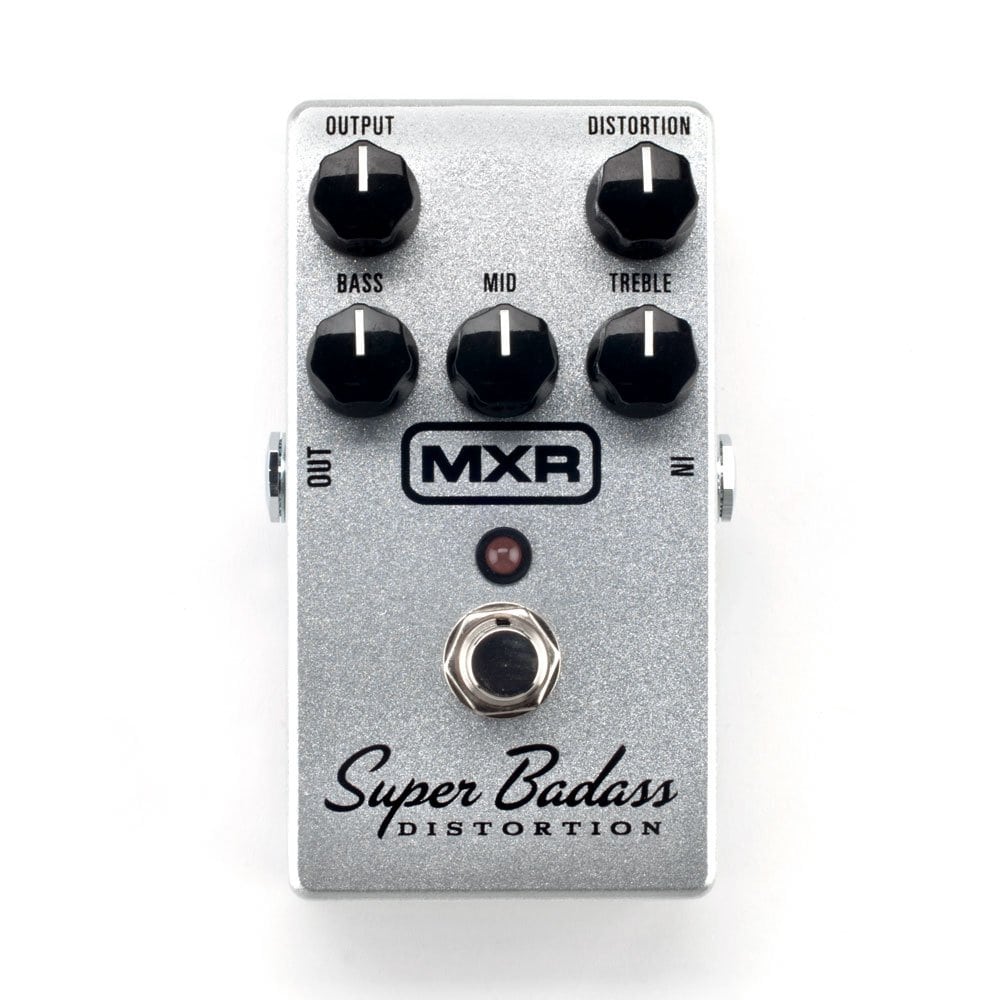
Editor’s Rating:
Features
The device comes in a very elegant glossy gray package, featuring a compact, sturdy build, and high-level craftsmanship. This is a 100-percent analog true bypass pedal, securing an organic and natural tone at a fair price. The stompbox is highly responsive, and utilizes an interesting feature – a full-on EQ to control the tone. Apart from that, there’s a single In Jack, and Out Jack, an LED status indicator, and an on/off foot-switch.
Controls
There are five control knobs in total – Output, Distortion, Bass, Mid, and Treble. The Output control, also known as the level control adjusts the level of distortion effect that’s injected into the audio output. The more it’s cranked up, the more distortion and less clean guitar signal you’ll get in the final mix.
The Distortion knob adjusts the level of gain, which is one of the crucial aspects of distortion and overdrive effects. It determines whether you’ll get a classic rock distortion of a full-blown modern metal groove. The Bass, Mid, and Treble knobs operate as a single entity, serving as the EQ control of the whole pedal.
Performance
The versatility of the MXR M75 is quite impressive for distortion pedal standards. The upper two knobs allow you to dial in anything from light rock distortion to groove metal and djent chugs, and then the EQ section gives you the possibility of tweaking the sound until it fits your needs to a tee.
The only complaint some users have is that the loudness is off the chart compared to other stompboxes.
Verdict
This is a very strong pedal that’s bound to satisfy any guitar player in pursuit of a modern style rooted in vintage vibe and tradition. The price is more than fair and the specs are great.
- The five control knobs make it very versatile.
- It’s quite easy to use.
- It’s durable and roadworthy.
- Some users have complained that it’s rather loud compared to other stompboxes.
7. Boss SD-1 Super Overdrive
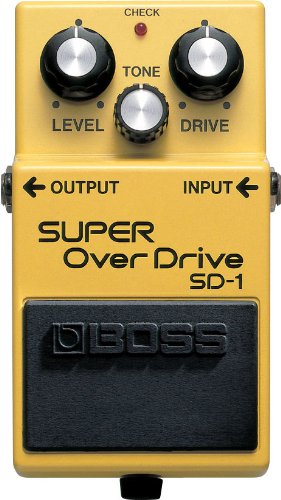
Editor’s Rating:
Features
Packed in a light green casing, this item is quite basic. It offers only the essential controls, but still secures a lot of sonic versatility and space to maneuver your sound into a variety of directions. As is the case with Boss pedals, there’s a single In-jack, one Out-jack, an LED status indicator, and a large on/off foot-switch. The device can be run through a single 9V battery or a standard power adapter, none of which are included in the price.
Control
Each of the knobs is very accurate and precise, allowing you to dial in any type of tone from light drive to full-on roar. In total, there are three knobs: Level, Tone, and Drive. The Level knob sets the amount of overdrive effect that gets injected into your audio output. The more you crank it up, the more overdrive and less clean guitar signal you’ll get in the final audio mix. The Tone knob determines the character and brightness of the OD effect. The more you dial in, the darker and more brass-driven your sound becomes, and vice-versa. Lower values secure a brighter and dry tone. The Drive knob is crucial as it adjusts the level of gain and drive. It’s through this knob that you’ll determine whether you want just a pinch of gain or full-blown tube OD boost.
Verdict
Overall, this is a top-notch overdrive pedal if you need versatility and solid sound at a fair price. This isn’t just a beginner stompbox, it’s much more than that. It’s easy to get a grasp of this guitar pedal’s capabilities and overall vibe in a short time. This means that you’ll get a pretty clear image from the get-go on whether or not this is the pedal for you.
- The pedal has a solid build quality.
- It comes with a large foot-switch.
- It’s a great signal booster for your instrument.
- It’s muddy at higher gain levels.
8. Jim Dunlop MXR Distortion+

Editor’s Rating:
Features
This is a basic pedal in terms of available controls, and it’s worth noting that inner circuitry is what gets most of the job done. There are two control knobs, one In- and one Out-jack. It also features an LED status indicator and a large on/off button for you to stomp. The gizmo is powered via a standard adapter and the metal casing is very sturdy and bright yellow.
Controls
The output knob is also knowns as the Level or Volume. This knob adjusts the level of distortion effect that’s injected into the audio output. The more you crank it up, the more distortion and less clean tone of your guitar you’ll get in the final tonal mix. The distortion knob controls the level of gain and overdrive, meaning that the more you crank it up, the heavier and crunchier your sound will be.
Performance
This is a hard rock and heavy metal pedal. The tone produced by this germanium-powered device is crunchy and tube-like. It sounds like much more expensive items, except it’s limited to the realm of heavy rock only.
Verdict
The MXR M104 Distortion+ can be considered one of the best heavy rock distortion pedals on the market within this price range. The tone, the build quality, sound control, and other features are top-notch. If you’re a rock ‘n’ roll person, you should consider getting this. It just might be your perfect choice.
- It’s simple to use.
- The pedal has a strong casing to ensure durability.
- The pedal can send a dry signal through unaffected when it’s off.
- It’s quite simplistic in design.
9. Ibanez TS9 Tube Screamer Classic

Editor’s Rating:
Features
With so many guitarists using Tube Screamers in their rigs, the features of this retro pedal speak for themselves. The TS9 retains the signature sonic characteristics of previous models, especially the heavy, growling midrange boost. This colored distortion pedal will add its unique sonic signature to your rig no matter which amp you play through, unlike other ‘transparent’ models that attempt to emulate your amp’s natural overdrive sound.
Controls
One of the great things about the Tube Screamer is its simplicity. With just three knobs, controlling drive, level, and tone, any player can quickly get the hang of adjusting this pedal. The drive dial adjusts your gain level and you can use it to find crunchy, bouncy rhythm textures or crank it for a bit of extra gain to get you through that big solo. The level control functions like an overall volume for your sound. Finally, tone control shapes the style of your sound. This effectively functions as a highlighter for the Tube Screamer’s distinctive tone – leaving it below noon gives a more even, balanced EQ palette, while diming the knob emphasizes the TS9’s midrange attack and snarl.
Performance
Tube Screamers and the myriad of pedals they’ve inspired are known for their gritty, expressive gain and strong mid boost. Players looking to pick one up should be aware that it’ll add a great deal of color to your sound – this is about as far as you can get from some trendier transparent distortion and drive pedals.
The TS9 Reissue offers a throaty, solid roar that solidifies into a hard-edged distortion with the tone and drive knobs cranked. Both crunchy, snappy rhythm textures and bright, prominent solo sounds are here in spades. At lower gain levels, this unit also boasts of great edge-of-breakup tones, perfect for blues and softer rock. The sound is a bit rough around the edges, the prominent mid boost and bass cut can turn your signal harsh or piercing if you’re not careful. However, this captures the throaty, midrange-thick tone beloved by generations of guitarists in all genres.
Verdict
With the Tube Screamer’s incredible history and distinctive sound, guitarists in almost any style can benefit by adding this new model to their setup.
- The TS9 is great for subtle to moderate overdrive.
- The pedal delivers top-quality audio output.
- It’s an iconic pedal that’ll complement your tone.
- This isn’t an especially versatile distortion pedal, and it has a cheap plastic battery cover.
10. MXR M102 Dyna Comp Compressor Pedal

Editor’s Rating:
Features
The classic remains true to its former design with its compact and tough chassis covered in red. It has your standard ins and outs, weighs 1-pound and requires either a 9-volt battery or a Dunlop AC power supply box to run. The richness of this fancy box is emphasized by the fact that it contains an “in-line” compressor that balances the signal to your amp flawlessly, disarming the need of manually controlling that specific aspect of your pedal. It also doesn’t destabilize your sound’s dynamics by providing expansive sustain.
Controls
The controls featured on the pedal are very easy and provide magnificent sustain with “Nashville” studio sound quality. The knobs in question offer tuning of Output and Sensitivity. Upping the output increases gain and aggression while the pedal itself modifies your low-end tones to match it. Tuning the sensitivity knob determines the amount of actual sound compression.
Performance
You’ll achieve awesome lead tones with excellent sustain that’ll aid in a stand out performance with this beautiful classic. If you want, you can dial the controls to their maximum and witness a more metal-like sound. These are just a few possibilities the MXR M102 Dyna offers. Play with the controls as you desire and you’ll find the perfect tone matching your needs, with just the right amount of sustain. The original intent and style of your sound will remain intact while smoothing it out or boosting it up to the extremes.
Verdict
There’s a good reason this masterpiece has remained with us for long, in spite of the dangerous completion offering pedals with higher flexibility. However, the MXR M102 Dyna Comp Pedal has kept its remarkable sound quality and it’s the go-to competition pedal for many guitar pros even to this day. At an extremely affordable price, this piece of work is perfect if you want to delve into the world of compression and expand the feel of your sound.
- It’s very sturdy and durable
- The pedal can be easily set up and is easy to use.
- It has stable dynamics essential in creating a clean sound even after “compressing” some notes.
- Some tone sucks when bypassed, and you can find a better tone and more options for tweaking your sound with other pedals.

